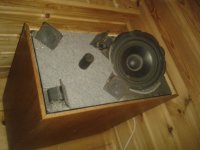SL's view was that omnis require near-field listening or a dead room, otherwise the ratio of indirect/direct sound will be too great. (He was very much concerned with stereo image, though.)
From what I've read SL was trying to reproduce the listening experience he had at his local orchestra performances.
All my experiences with live sound and reproduction using every type of speaker and headphone I can think of I came to this idea. To sound realistic in a way that relates to a real world listening experience a performance needs occur in an acoustical space that leaves it signature on the sound generated by the instruments and vocalists. For the most realistic playback you have two limits.
At one end, a performance captured in a space with lots of ambient reflections, hall characteristics etc that is then reproduced with front firing narrow directivity speakers in a dead room, that adds no information from the playback acoustic space. This gives a window into the original performance with only the venue character in tact. Think recording studio mixing room.
The other end of the spectrum is the exact opposite. Maybe a small quartet, or chamber music or even a large orchestra group recorded in a nearly dead space, like a practice room that is played back with very very wide directivity speakers (wide directivity dipole or omni) in a somewhat live room, such that the room imparts the same character on the performers sounds as if they were performing in the playback room. The sound bouncing off the walls, ceiling and floor in all directions is what provides all the cues for your brain to locate these performers in your listening space. B&O describes this really nicely in there Beo 90 white paper.
So playing an omni or wide pattern dipole in a dead room or playing a narrow front pattern speaker in a very lively room is a missed opportunity for a more enveloping or engaging experience. With so much music that was recorded with a microphone on every instrument with artificial and different acoustic spaces for each instrument and then moved around between channels using pan-pots could sound fine, a lot of music is just a confusing mess that is likely best played back on the exact system it was mastered on, narrow dispersion speakers in a dead room.
Hmmm. My studio is more damped than the avg LR. Sloped ceiling has the "acoustics panels" used for drop ceilings, no drywall, and 12" of fiberglass behind them. So no floor/ceiling standing waves. Also the top 3' of the back wall is one giant bass trap made of 8" thick Blue Fill (recycled cotton). These might make the room more suitable for omni than usual.SL's view was that omnis require near-field listening or a dead room, otherwise the ratio of indirect/direct sound will be too great. (He was very much concerned with stereo image, though.)
I find that overlaying the recorded ambience of the concert hall with the natural ambience of my listening room is not an actual problem. The impression is that of a bigger room, with the musicians further away than they could be in my room. My room has average damping (wall-to-wall carpeting, sofa, and popcorn ceiling).
Ed
Ed
All this will create the typical sound (good imaging with sensation of depth) that is best suited for classical or other well recorded acoustical or vocal stereo recordings. The practical importance of backside spl and radiation smoothness is questionble though...
Zappa, Live At The Roxy.
Hardly acoustical.
Awesome spacing and placing of instruments and vocals.
That's my experience too. The most convincing sense of depth/spaciousness, to my ears, happens when the recording has plenty of ambience/reverberation, and when the speaker setup creates some room sound - but minimising early reflections as much as possible. Hence my fondness for dipoles.I find that overlaying the recorded ambience of the concert hall with the natural ambience of my listening room is not an actual problem
